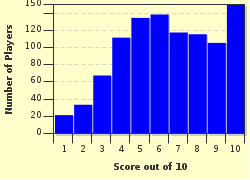Quiz Answer Key and Fun Facts
1. The curious situation of Erwin Schrödinger's cat sets physicists to growling, but it's actually quite simple to describe. The unfortunate feline is sealed into a box. The box has plenty of air, but it also has a vial of poisonous gas -- which will be released if a single unstable atom (also in the box) decays. Why did Schrödinger choose radioactive decay as the quantum process that would trigger the paradox?
2. So Schrödinger's cat is in a box, along with a poisonous gas that will be released if one atom undergoes radioactive decay. Which of these items can be used to detect the decay of an atom, and thus to cause the release of the gas?
3. Let's take a quantum-mechanical look at what's happening to Schrödinger's cat. Either the atom has decayed and the cat is in quantum heaven, or the atom and the cat are intact. Physicists describe this kind of situation with something called a wave function, which includes what important information?
4. The box is sealed. Schrödinger's cat is inside with its owner's deadly apparatus. You might think that it's either alive or dead, but you'd be wrong: many quantum physicists would say that it's BOTH alive and dead. The cat somehow exists in both possible states until the universe is forced to make up its mind. What is this strange situation called?
5. The mathematical description of Schrödinger's cat is made even more complicated by the fact that it doesn't just describe the cat. If you know the state of the cat, you also know the state of the radioactive atom and (eventually) of the observer. What is the name for this deep connection between the quantum states of different physical objects?
6. Well, this is awkward: we have a cat in a box, and it's somehow both alive and dead at the same time. What's a physicist to do? According to the popular Copenhagen interpretation, this confused state of affairs won't last forever. At what point does it say the cat will settle into a single, well-defined state of being?
7. Another school of thought tries to avoid the Copenhagen interpretation's problems entirely, by proposing a branching universe. The idea is that the cat is still both alive and dead after the box is opened, but that the universe has branched: one universe has a live cat and the other has a dead cat, and the two proceed independently of each other. What is this method for interpreting quantum mechanics called?
8. Still other physicists argue that the Schrödinger's cat problem is a problem only because it's too narrow in scope. Of course it doesn't make sense if you think about a single cat: you have to think about hundreds or thousands of cats, each in an identical box. What term, more familiar in statistical mechanics or in dance troupes, describes this situation?
9. At this point, you might be wondering how normal cats manage to get through the day without triggering multiple physical and philosophical paradoxes. Luckily, cats usually behave according to the much more intuitive rules of classical physics. But a cat is made of quantum particles; why wouldn't it behave as a quantum object? Name the mechanism by which quantum systems give rise to classical behavior.
10. Schrödinger's cat and its box never really existed, of course: they were figments of Erwin Schrödinger's fertile imagination. The quantum feline is part of a long, grand tradition in physics: that of reasoning through some hypothetical (and often technically impossible) situation in order to understand the implications of a theory. What is this type of exercise called?
Source: Author
CellarDoor
This quiz was reviewed by FunTrivia editor
crisw before going online.
Any errors found in FunTrivia content are routinely corrected through our feedback system.

